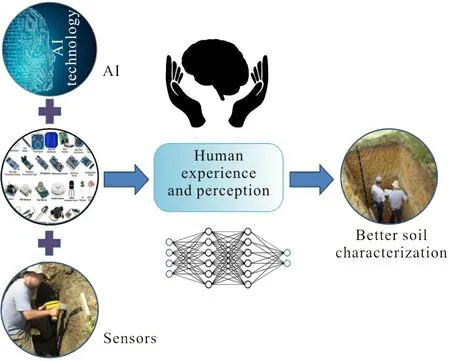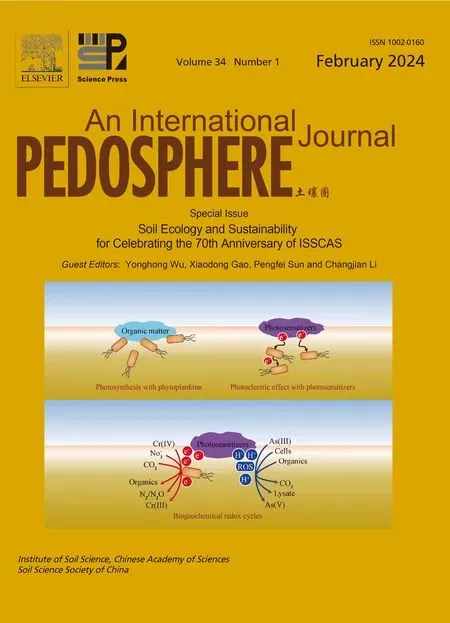Balancing machine learning and artificial intelligence in soil science with human perspective and experience
Machine learning and artificial intelligence continue to evolve at a rapid pace,with many potential applications related to soil science.Even so,human experience and perception play an invaluable role in characterizing soil properties,especially qualitative properties that may elude sensing/computer-based modeling approaches.The elegant solution to this conundrum relies on the synthesis of computer-aided predictive modeling with human insight and knowledge.
As global population surpasses 8 billion,the importance of optimized agronomic production to feed a hungry world has never been more important.This directly intersects with the Sustainable Development Goals(SDGs)of the United Nations(UN,2023),specifically SDG 2-Zero Hunger,SDG 11-Sustainable Cities and Communities,and SDG 15-Life on Land.Enhanced soil characterization and environmental quality assessment play a vital role in ensuring that soils can rise to meet the need for augmented agricultural production.To meet this challenge,a wide array of proximal and remote sensors have been developed and applied to characterize soils over the past two to three decades.These approaches include portable X-ray fluorescence(PXRF)spectrometry(Silvaet al.,2021),laser-induced breakdown spectroscopy(LIBS)(Villas-Boaset al.,2020),visible near infrared(Vis-NIR)spectroscopy(Viscarra Rosselet al.,2006),portable color sensors (e.g.,NixPro) (Stiglitzet al.,2017),smartphone image analysis(Swethaet al.,2020),hyperspectral drone/satellite imagery(Allamet al.,2019),and global positioning system(GPS)technologies.In many cases,these technologies have enabled laboratory quality analysis,insitu,in seconds,successfully characterizing a wide variety of soil physicochemical properties(e.g.,soil organic carbon,cation exchange capacity,nutrients essential for plants,pH,and salinity)and soil pollutants(e.g.,hydrocarbons,heavy metals,and organic chemicals).
While some sensor approaches report data directly,many infer soil properties from ever more sophisticated predictive algorithms and machine learning(ML)approaches.Just as spatial analysis would rely upon kriging,inverse distance weighting,or other geostatistical approaches,predictive algorithms in soil science are often built using random forest regression,support vector machine,XGBoost,etc.(Breiman,2001).Wadouxet al.(2021)note that progress based on data accumulation and ordering is not new to soil science.In fact,Wadouxet al.(2021)argue that“most of the components of the present-day data-driven soil research are perhaps just a reflection of a change in the magnitude of the amount of data collected and their storage and in the capacity to analyze them with complex statistical tools aided by computational power.”As the quantity of data collected continues to expand,local or regional models are now empowering emergent global models.Processing of large,advanced models now requires supercomputing or cloud computing.While these approaches provide amazing new power for characterizing the environment in which we live,human perception,experience,and intuition remain equally,if not more relevant,than ever.
For example,NASA’s Curiosity rover on Mars is equipped with a wide array of the most advanced instrumentation ever developed(e.g.,spectrometers,cameras,radiation detectors,atmospheric and environmental sensors,etc.).Even so,it has struggled to definitively answer the question of whether life in any form exists beyond Earth.Sensors often face a litany of logistical challenges;they require calibration and can often be compromised by harsh environmental conditions.For example,if vegetation or coarse fragments pierce the protective film across the PXRF aperture,dust can enter the mechanism,jamming the filter wheel.Similarly,drone or satellite image detection is commonly compromised by vegetative cover or atmospheric conditions.
Sensors may also struggle with qualitative soil quality indices such as soil tilth.Karlen(2005)defines tilth as“the physical condition of soil as related to its ease of tillage,fitness as a seedbed,and its promotion of seedling emergence and root penetration.”Tilth is not singularly tied to soil texture,structural aggregation,or moisture status,but rather an ever-changing combination of a litany of factors.Experienced agronomists may not be able to measure tilth quantitatively,but they intrinsically know good soil tilth when observed.Similarly,sensors may struggle to adequately characterize soil structural grades or secondary carbonate development stages,which often vary regionally.Morphological assessment of structural grade is not only a product of basic concepts of pedogenesis,but also a natural extension of analysts’personal experience,travels,and field observations,even echoing the academic lineage of who they studied under(e.g.,their academic trees).
Over decades of experience,a keen ability to read a landscape and understand not only what and where soils are likely to develop across the landscape,but also why they develop in such a manner with deference to the factors of soil formation has been developed by the Soil Survey Staff(e.g.,US Department of Agriculture Natural Resources Conservation Service,Agricultural Research Service,and Cooperative Soil Survey) (Jenny,1994).Google Bard,ChatGPT,and other artificial intelligence (AI) platforms offer powerful means of processing data,but their ability to overtake human knowledge and experience in soil science remains emergent.
Artificial intelligence and ML technologies are revolutionizing soil science by attempting to incorporate human perspective and experience.With the aim to simulate human cognitive functions such as learning,problem solving,perception,and decision-making,AI involves the design and implementation of algorithms,models,and systems that enable machines to perceive and understand their environment,reason and make decisions based on available data,and take appropriate actions to achieve specific goals.Contrariwise,ML is a subset of AI that focuses on the development of algorithms and models that allow computers to learn from and make predictions or decisions based on data without being explicitly programmed.The ML algorithms are designed to automatically analyze large datasets,identify patterns,and extract meaningful insights to improve their performance over time.Through a process of training on labeled or unlabeled data,the ML models can generalize from examples and make accurate predictions or decisions on new,unseen data.The ML techniques include various approaches such as supervised learning,unsupervised learning,reinforcement learning,and deep learning,each with its own specific applications and algorithms.In soil science applications,the ML models are trained on labeled (e.g.,soil textural classes)or unlabeled data,learning to predict soil properties such as pH,texture,and more(Chakrabortyet al.,2010;Sharmaet al.,2014;2015;Wanget al.,2015).Extracted features,including spatial and climatic variables,contribute to the model’s learning process.Through training,the model grasps patterns and relationships within the data.This enables it to generalize beyond training examples,making accurate predictions on new,unseen soil samples.This predictive ability aids in precision agriculture,land-use planning,and environmental management.Validation ensures prediction accuracy,refining the model if needed.Ultimately,ML empowers soil scientists to draw insights from data and effectively predict soil behavior.In addition,ML has revolutionized the field of digital soil mapping by enabling the extraction of valuable insights from vast amounts of legacy soil data.By learning patterns and relationships within soil data,the ML algorithms can produce accurate soil maps,aid in predicting soil properties,and support decision-making in various applications such as spatial interpolation,land suitability analysis,erosion risk assessment,digital elevation model (DEM) creation,time series analysis of soil properties,and uncertainty analysis (Heunget al.,2016;Wadouxet al.,2020).Even so,Rossiter(2018)cautions that“with increasing computing power there is a temptation to use all available characteristics;this can lead to discovery of unforeseen patterns but also to meaningless relations.”
Traditionally,soil scientists have relied on manual observation and data collection methods,which are time consuming and limited in scope.However,with the advent of AI and ML,researchers now have access to powerful tools that can analyze vast amounts of data and extract meaningful insights (Fig.1).By leveraging ML algorithms,these technologies can process diverse soil data,such as chemical composition,physical properties,and microbial activity,to identify patterns,correlations,and anomalies that may be difficult for humans to discern.For example,Padarianet al.(2020)note that ML methods in soil science are commonly used in remote sensing and soil organic carbon,water,contamination,erosion,and parent material characterization.They further note that modellingviaML can also be used to improve our understanding of the causes of soil variation.Maet al.(2019)concur,stating that“new relationships revealed by ML analysis can help stimulate ideas,generate hypotheses,and formulate future questions for research.”Furthermore,AI models can be trained on extensive datasets,including historical records and expert knowledge,to develop models that can predict soil properties and behavior under different conditions.The AI-powered sensors and robotics enable real-time monitoring of soil conditions,optimizing irrigation and fertilization practices(Spanakiet al.,2022;Javaidet al.,2023).This integration of human expertise and AI capabilities not only accelerates research,but also enhances our understanding of soil dynamics,leading to more effective agricultural practices,sustainable land management,and improved soil health.

Fig.1 Artificial intelligence(AI)combined with human experience and perception for improved soil characterization.
Despite the progress of AI in soil science,scientists’experience and knowledge remain crucial for several reasons.First and foremost,soil science is a multidisciplinary field that encompasses various complex interactions between physical,chemical,and biological components.Scientists bring years of education,training,and practical experience to understand the nuances and intricacies of soil systems.This expertise helps design appropriate experiments,interpret results,and contextualize findings within broader scientific knowledge.Additionally,soil science often involves working with diverse and dynamic environmental conditions that may not be fully captured by available datasets.Scientists possess the ability to identify and consider contextual factors,such as local climate patterns,historical land use practices,and unique soil characteristics that can significantly influence soil behavior.They can apply their judgment and domain knowledge to make informed decisions in situations where data may be scarce,incomplete,or conflicting.Moreover,scientists provide valuable insights in the form of subjective observations and tacit knowledge that might be challenging to capture through quantitative data alone.Their ability to detect subtle changes in soil conditions,recognize anomalies,and identify potential limitations or biases in data can greatly enhance the accuracy and reliability of soil science research.In essence,there are soil phenomena that may be statistically insignificant,yet important,or statistically significant,yet of little practical importance.Lastly,scientists play a crucial role in validating and interpreting AI-generated results.While it is true that AI algorithms have historically excelled at processing soil data and identifying patterns without providing detailed explanations for their predictions,the field of AI has made significant strides in enhancing interpretability and transparency.Modern AI techniques,such as explainable AI(XAI)(Gunninget al.,2019),now aim to bridge this gap by offering methods to elucidate the decision-making process of complex models.These techniques enable soil scientists to gain insights into the factors influencing AI-generated predictions and validate those predictions against soil science knowledge.This evolving landscape of AI in soil science reflects a positive trend towards not only accurate predictions,but also a deeper understanding of the underlying mechanisms driving soil behavior and properties.Nevertheless,scientists can critically evaluate AI-generated insights,conduct further experiments to validate findings,and provide meaningful interpretations based on their understanding of soil science principles.
Summarily,AI integration in soil science augments research capabilities,but scientists’experience and knowledge are essential for contextualizing findings,addressing complex environmental factors,incorporating subjective observations,and ensuring the completeness,validity,and interpretation of AI-generated results.Collaboration between AI and human expertise leads to a more comprehensive understanding of soil systems and enables more informed decision-making in agriculture,land management,and environmental sustainability.The combination of AI and human experience in soil science is empowering researchers to make informed decisions and contribute to the preservation and enhancement of one of Earth’s most vital resources-soil.
- Pedosphere的其它文章
- Removal of atmospheric methane by soil ecosystems and its controlling variables from microbial to global scales
- Preface:Special issue on soil ecology and sustainability for celebrating the 70thanniversary of ISSCAS
- Responses of nitrogen cycling and related microorganisms to brackish wetlands formed by evapotranspiration
- Assessment of soil total phosphorus storage in a complex topography along China’s southeast coast based on multiple mapping scales
- Application of controlled-release urea increases maize N uptake,environmental benefits and economic returns via optimizing temporal and spatial distributions of soil mineral N
- Effects of herbicide butachlor application on the growth of periphytic biofilms and nitrogen loss in paddy systems

